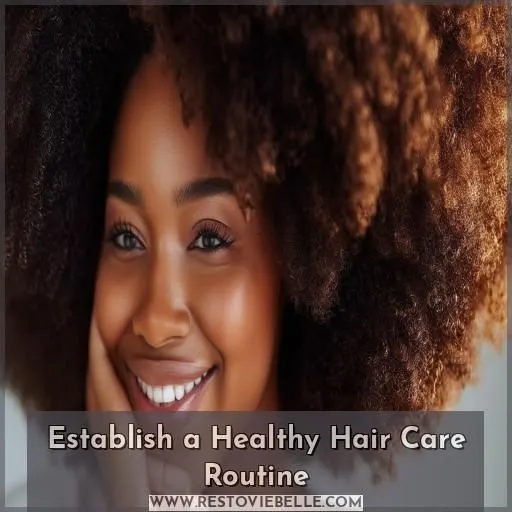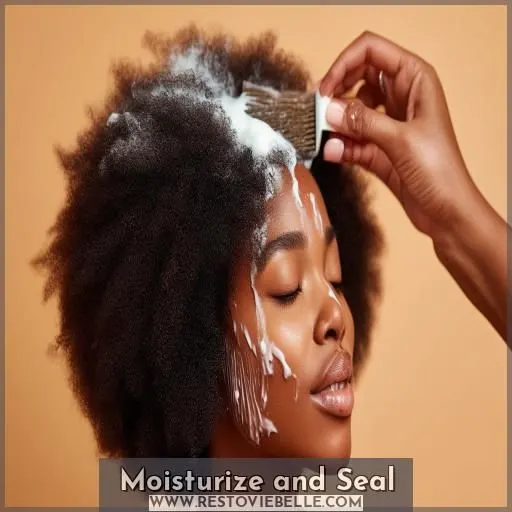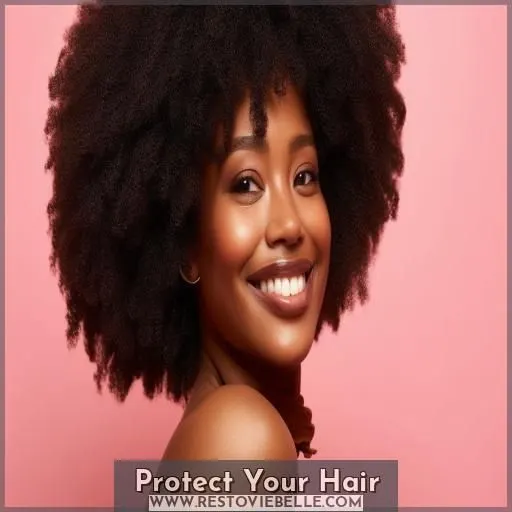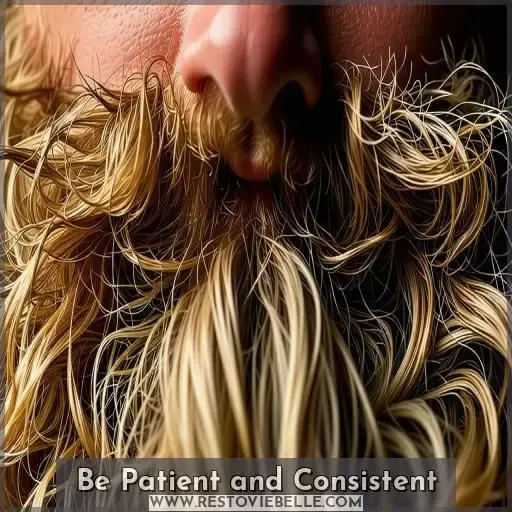This site is supported by our readers. We may earn a commission, at no cost to you, if you purchase through links.
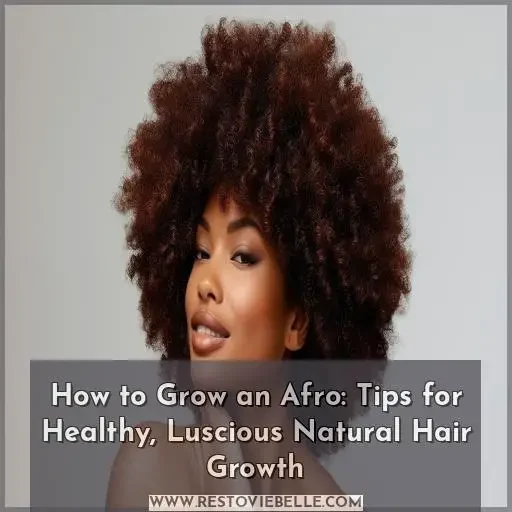 You’re seeking to embrace your natural hair texture and let it flourish into a luscious afro? Awesome!
You’re seeking to embrace your natural hair texture and let it flourish into a luscious afro? Awesome!
Cleanse and condition regularly with sulfate-free products.
Deep condition weekly, and avoid excessive heat styling.
Spritz on a water-based leave-in, apply a moisturizing cream/butter, and seal with a lightweight oil.
Wear protective styles like braids.
Sleep on a satin pillowcase, and trim split ends.
Stay hydrated, consider hair supplements, and manage stress.
Be patient – afro hair grows about 1/2 inch monthly.
Consistent care is key, so celebrate small wins.
Ready to learn the specific steps for your natural hair journey?
Table Of Contents
- Key Takeaways
- How to Grow an Afro?
- Understand Your Hair Type
- Establish a Healthy Hair Care Routine
- Moisturize and Seal
- Protect Your Hair
- Nourish From Within
- Be Patient and Consistent
- Frequently Asked Questions (FAQs)
- How long does it take to grow an afro?
- How to grow afro hair for beginners?
- Can everyone grow an afro?
- Why can’t I grow an afro?
- Can hair vitamins boost afro hair growth?
- How often should you trim an afro?
- Is protective styling necessary for afro growth?
- What role does exercising play in growth?
- Are there seasonal variations in afro growth?
- Conclusion
Key Takeaways
- Consistency is the name of the game, folks! Treating your coils with TLC through a diligent routine is crucial for that enviable ‘fro. Slow and steady wins the race, as they say.
- Moisturize, seal, protect, and repeat! Keeping those strands hydrated and happy is job one. A little pampering with creams, oils, and satin coverings goes a long way.
- Be patient, grasshopper. Growing an afro takes time – we’re talking months of nurturing before you see major progress. But trust me, it’ll be worth the wait when you’re rocking that crown of glory!
- At the end of the day, this journey is about more than just luscious locks. It’s an act of self-love and embracing the beautiful diversity within our community. Rock that ‘fro with pride, my friend!
How to Grow an Afro?
To grow an afro, establish a healthy hair care routine that includes moisturizing and protecting your natural hair texture. Be patient and consistent with your regimen, as afro hair typically grows about 1/2 inch per month.
Understand Your Hair Type
Understanding your distinct hair type is essential for cultivating an enviable afro. Establish if your strands exhibit waves, curls, or coils, and ascertain their porosity levels and density to tailor a successful growth regimen.
Determine Your Hair Type
Examine your locks – are they straight, wavy, curly, or kinky? Length matters too – short or long? Thickness counts – fine, medium, or coarse? Understanding your hair’s unique makeup guides your haircare journey. The right products and techniques specific to your hair type promote healthy growth and flourishing afro brilliance.
Identify Your Hair Porosity
After determining your hair type, identify its porosity. This affects how well your hair absorbs and retains moisture. Here are three simple porosity tests:
- Strand Test: Drop a strand in water. Low porosity repels water; high porosity absorbs quickly.
- Product Absorption: Notice how products sink in or sit on top.
- Shedding: High porosity leads to more shedding.
Knowing your porosity level guides your hydration and protein needs.
Assess Your Hair Density
After gauging your hair porosity, determine your hair density. Dense hair demands more hydration and nourishment to support natural growth. Modify your product choices accordingly – lightweight oils if you have fine strands, thicker creams for coarser textures. This approach guarantees ideal scalp health and breakage prevention.
Establish a Healthy Hair Care Routine
To establish a healthy hair care routine, you should cleanse and condition your hair regularly using sulfate-free and silicone-free products that are gentle on your strands. Weekly deep conditioning treatments are also essential to keep your hair moisturized and prevent breakage, while avoiding excessive heat styling will minimize damage and promote healthy growth.
Cleanse and Condition Regularly
You’ll want to cleanse and condition your hair weekly. Use a sulfate-free, silicone-free shampoo and conditioner to gently remove buildup without stripping moisture. Deep condition at least once a week to replenish and strengthen strands. Consistency in your regimen is key for afro growth and health.
Use Sulfate-free and Silicone-free Products
You’ll also want to use sulfate-free and silicone-free hair products. Sulfates strip your hair of its natural oils, leaving it dry and brittle. Silicones coat the hair, preventing moisture from penetrating the strands. Opt for gentle, moisturizing cleansers and conditioners formulated specifically for natural hair to retain essential hydration and promote healthy growth.
Deep Condition Weekly
After avoiding harsh sulfates and silicones, you’ll want to deep condition weekly. Deep conditioning replenishes moisture and strengthens strands, promoting growth. Try hair masks with natural oils, or whip up a homemade avocado and honey treatment. Gently massage the conditioner into your scalp using your fingertips for improved circulation.
Avoid Excessive Heat Styling
You’ll want to limit heat styling as much as possible.
Excessive heat from blow dryers, flat irons, and curling wands can lead to dreaded heat damage and breakage.
When you must style with heat, always use a heat protectant and keep the temperature low.
Better yet, opt for protective styles like braids or twists that put your hair into a low-manipulation state.
Moisturize and Seal
To keep your afro hair moisturized and healthy, start by spritzing it with a water-based leave-in conditioner.
Then, follow up by applying a moisturizing cream or butter to seal in the hydration.
Finish with a lightweight oil to lock in the moisture and prevent dryness.
Be careful not to over-manipulate your hair when it’s dry, as this can lead to breakage.
Spritz With a Water-based Leave-in Conditioner
After cleansing and conditioning, spritz your hair with a water-based leave-in conditioner. This lightweight product will add moisture and detangle, prepping your strands for the next step. Look for ingredients like aloe vera, glycerin, and botanical oils to keep your afro hydrated and healthy while you style.
Apply a Moisturizing Cream or Butter
After spritzing with a leave-in conditioner, follow up with a rich moisturizing cream or butter. Apply it generously, focusing on your ends and any dry sections. Here are some great options to consider:
- Shea butter
- Coconut oil-based creams
- Avocado butter
- Aloe vera gels
Work the product through evenly from roots to tips for deep hydration.
Seal With a Lightweight Oil
After applying your moisturizer, seal in the hydration with a lightweight oil. This creates a protective barrier, preventing moisture loss. Oils like argan, jojoba, and grapeseed are excellent choices for sealing.
| Oil | Benefit |
|---|---|
| Argan | Vitamin-rich, prevents breakage |
| Jojoba | Mimics sebum, absorbs easily |
| Grapeseed | Lightweight, anti-inflammatory |
Focus on your ends and seal from mid-length to tips.
Avoid Over-manipulating Dry Hair
Once your hair is moisturized and sealed, avoid over-manipulating it while dry to prevent breakage. Follow these tips:
- Detangle gently when damp or misted
- Minimize brushing or combing
- Wear protective styles when possible
- Avoid tight hairstyles that pull on strands
Treating your hair delicately while dry will help retain moisture and minimize damage, promoting healthy growth.
Protect Your Hair
To protect your hair and promote growth, incorporate protective styles like braids or twists into your routine. These minimize friction and tension, shielding your strands from breakage. At night, cover your hair with a satin bonnet or sleep on a satin pillowcase; this prevents moisture loss and further damage.
Wear Protective Styles Like Braids or Twists
One way to safeguard your curls is by wearing protective hairstyles like braids or twists. These lengthy styles minimize friction and handling, allowing your hair to thrive. They offer a break from daily styling routines, and they also provide a stylish way to protect your ends from damage while supporting new growth.
Use a Satin Bonnet or Pillowcase at Night
Continuing your protective hair journey, you’ll want to minimize friction and moisture loss at night. Here’s how a satin bonnet or pillowcase can help:
- Prevents dryness and breakage from cotton pillowcases
- Retains moisture by reducing friction
- Protects styles like twists and braids
- Minimizes frizz for smoother mornings
- Creates a protective barrier for delicate strands
Your nighttime hair routine is just as paramount as your daytime care. Invest in satin hair protection for premium growth.
Limit the Use of Hair Accessories
Be cautious with hair accessories as they can lead to breakage and tangles. Over-manipulation from styling tools like combs and brushes can also damage your tresses.
| Tool | Recommendation |
|---|---|
| Combs | Use wide-tooth combs |
| Brushes | Avoid traditional brushes |
| Pins | Limit use to minimize breakage |
| Rubber Bands | Avoid tight bands that snag hair |
Minimize accessory use to protect your afro’s health and growth.
Trim Split Ends Regularly
Regular trims are essential to removing split ends, preventing further breakage, and promoting healthy growth. Aim to trim your afro every 6-8 weeks using sharp scissors or shears. Section your hair, snip off any split, thin ends, and lightly dust the lengths. With proper trim techniques, you’ll avoid damage while keeping your afro looking fresh and full.
Nourish From Within
You should stay hydrated by drinking plenty of water, as it nourishes the hair follicles and promotes healthy growth. Considering taking hair growth supplements with essential vitamins and minerals can also give your hair the nourishment it needs from within, but be sure to consult a professional first.
Stay Hydrated by Drinking Plenty of Water
After protecting your hair, stay hydrated by drinking plenty of water. Proper water intake fuels:
- Hair follicle nourishment
- Scalp oil production
- Overall body function
Set a daily hydration schedule to consume at least 2 liters of water. Adequate fluid consumption supports healthy hair growth from the inside out.
Consider Taking Hair Growth Supplements
You might also consider taking hair growth supplements to nourish your strands from within. Biotin and zinc are essential for promoting growth, so look for formulas containing these nutrients. However, supplements alone won’t do the trick – make certain you’re also rocking protective hairstyles and maintaining a balanced vitamin intake for the best results.
Manage Stress Levels
You know stress can wreak havoc on your tresses. So, practice some self-care! Meditate, take nature walks, or indulge in a hobby you love. Managing stress is key to allowing your hair’s growth cycle to thrive. When you’re calm and centered, your hair will thank you with luscious, flourishing curls.
Be Patient and Consistent
Growing an afro takes time and patience, as natural hair typically grows at a rate of around 1/2 inch per month. Consistency is key – stick to a healthy hair care routine, celebrate small wins along the way, and embrace your natural hair journey with pride.
Afro Hair Grows About 1/2 Inch Per Month
Hair growth is a slow process, so patience is key. Afro hair typically grows around 1/2 inch per month. While this rate may seem frustrating, it’s normal and healthy. Focus on scalp health, minimizing breakage, and nourishing strands to maximize growth potential. With consistent care and realistic expectations, you’ll see progress over time.
Consistent Care is Key to Healthy Growth
You’ve got to be consistent with your hair care routine for healthy growth. Moisturize regularly, wear protective styles, eat a nutritious diet, and trim split ends. It may seem tedious, but sticking to these practices will minimize breakage and maximize your Afro’s growth potential. Don’t get discouraged – consistent care pays off!
Celebrate Small Milestones Along the Way
You’ve put in consistent effort, so celebrate those small wins! Notice when your hair feels more moisturized or when you see:
- Less shedding
- Fewer split ends
- Increased length retention
These milestones motivate you to stay patient and keep up the consistent care. Your natural hair journey has ups and downs, but appreciating progress fuels your commitment.
Embrace Your Natural Hair Journey
Embrace your natural hair’s beauty – it’s a crown of self-acceptance and cultural pride. This journey celebrates the diversity within our community and affirms your authentic self. Appreciate each milestone, for growing an Afro requires patience, love, and an unwavering commitment to nurturing your roots. It’s a powerful act of inclusivity and self-affirmation.
Frequently Asked Questions (FAQs)
How long does it take to grow an afro?
Growing an afro takes time and dedication. You can expect it to take around 6-12 months to achieve a full, glorious ‘fro when starting from a short cut. Consistency with your hair care routine is key to reaching your coily crown goals.
How to grow afro hair for beginners?
Funny you should ask – growing an afro takes patience and care. Start by ditching harsh chemicals and heat styling. Moisturize daily with natural oils, and handle your coils gently. Trim regularly, eat a balanced diet, and your glorious ‘fro will flourish!
Can everyone grow an afro?
Not everyone can grow an afro effortlessly. Hair type, genetics, and proper care play essential roles. However, with dedication and the right techniques, most people of African descent can achieve an enviable afro. Consistency is key – be patient and nurture your hair’s journey.
Why can’t I grow an afro?
You may struggle to grow an afro if your hair texture isn’t coily enough or if you lack proper hair care. Genetics, diet, and hormones can impact hair type and growth rate. With patience and the right technique, though, many can achieve an enviable ‘fro.
Can hair vitamins boost afro hair growth?
Hair vitamins with biotin, vitamins C and E, zinc, and protein can boost cell growth and strengthen hair follicles for faster afro growth. But consistent moisture and gentle handling are key too.
How often should you trim an afro?
You should trim your afro every 6-8 weeks to remove split ends and promote healthy growth. Regular trims keep hair looking fresh, shapely, and prevent excessive breakage.
Is protective styling necessary for afro growth?
While not a strict necessity, protective styling can certainly aid afro growth. By minimizing friction, these hairstyles allow your strands to thrive without excessive breakage or manipulation.
What role does exercising play in growth?
Exercising boosts circulation, providing nourishing oxygen and nutrients to hair follicles. The increased blood flow also removes toxins, promoting growth. Plus, sweating removes excess buildup and oils that can clog pores, allowing hair to thrive.
Are there seasonal variations in afro growth?
You bet – afro growth often slows during winter’s dry air. But don’t sweat it; come spring, those coils will spring back to life.
Conclusion
Growing an afro is a rewarding journey that requires patience and dedication. With consistent care, nourishment, and protection, you’ll be rewarded with healthy, luscious natural hair growth. Embrace your hair’s unique texture, celebrate small wins, and trust the process – your stunning afro awaits you.

